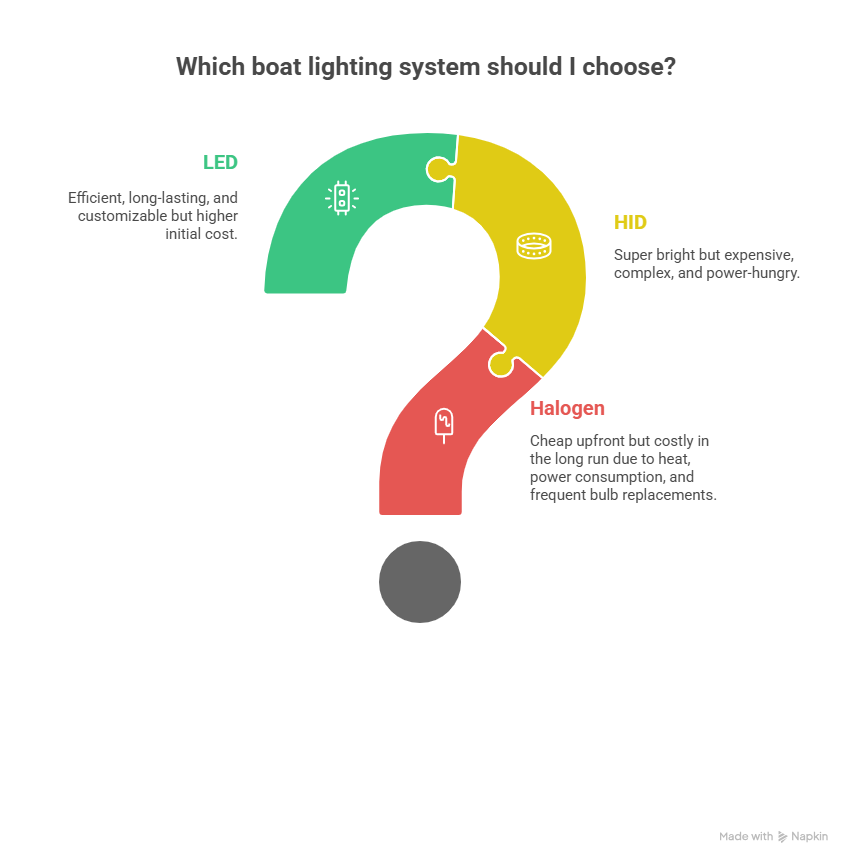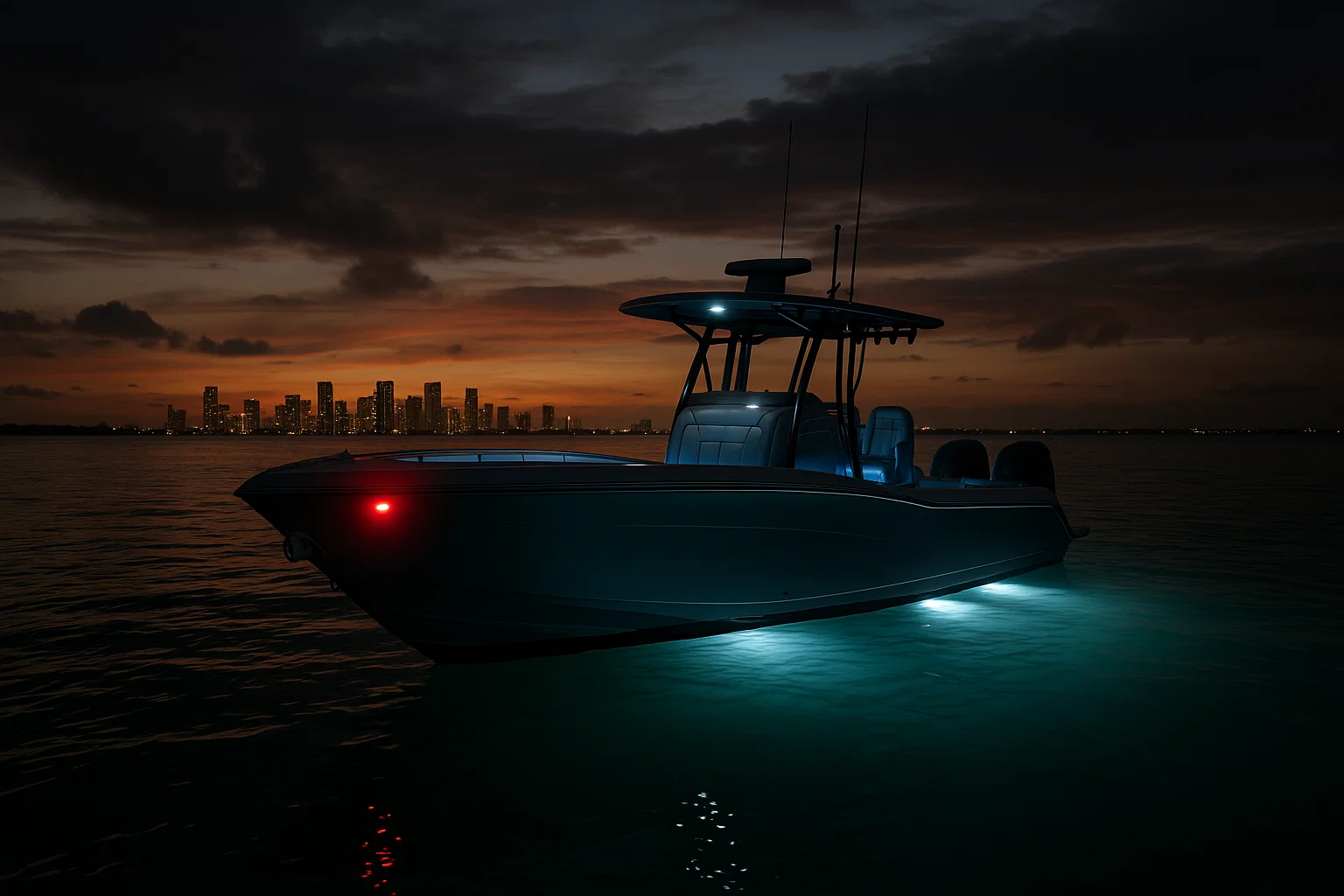A Near Miss Off Key Biscayne
Let me tell you a story. A few years ago, I was helping a client, Maria, bring her Sea Ray 320 back to Miami from the Keys. It was pitch black, one of those moonless Florida nights. Suddenly, my heart jumped into my throat. A small, unlit fishing skiff appeared out of nowhere, maybe 50 feet off our bow. A ghost. We swerved hard, and disaster was avoided by inches. The guy on the skiff just waved like nothing happened. Maria was shaken. Her first question when we docked? “Are my lights good enough?”
That moment sticks with me every time I talk about boat lighting systems. It’s not about looking cool with fancy blue underwater lights—though we’ll get to that. It’s about not becoming that ghost ship. It’s about seeing and, more importantly, being seen. Your boat lighting systems are one of the most critical safety features you have, and frankly, a lot of people get it wrong.
So let’s talk turkey. I’m going to break down what you actually need, what’s nice to have, and how to avoid the cheap junk that will fail you when you need it most.
Table of Contents
Why Your Boat Lights Are More Than Just Pretty Colors
Staying Safe and Legal
First things first: the rules. The U.S. Coast Guard doesn’t mess around with lighting. The COLREGs (the “rules of the road” on the water) are law for a reason. They exist so we don’t run into each other in the dark. Having the right navigation lights—red on the port, green on the starboard, white on the masthead and stern—isn’t a suggestion. It’s your ticket to not causing a collision or getting a hefty fine. I’ve seen guys at the Dinner Key boat ramp get ticketed for a single burnt-out bulb. A proper boat lighting system is your first line of defense.
But it’s more than just avoiding other boats. Good deck lighting helps you see what you’re doing when docking at night. A decent spotlight can help you spot a channel marker or a crab pot line before you run it over. This stuff isn’t luxury; it’s basic seamanship.
The Old vs. The New: Why I Only Install LEDs Now
I’ve ripped out more old, corroded halogen boat lighting systems than I can count. Those old-school lights were hot enough to melt plastic, devoured battery power, and the bulbs seemed to last about five minutes in a saltwater environment. We’ve got better options now. Much better.
Here’s how I break down the tech for my clients when they ask about upgrading their boat lighting systems:
| Technology | What I Like About It | What I Don’t Like | My Take |
|---|---|---|---|
| Halogen | Cheap to buy upfront. That’s it. | They get incredibly hot, eat power like crazy, and the bulbs constantly burn out. | Avoid. It’s 2025. This is ancient tech. You’ll spend more on bulbs and battery charging in the long run. |
| HID | Super bright. Good for big searchlights. | Expensive, complex, and still suck a fair bit of power. Takes time to warm up. | Niche use. Maybe for a big commercial boat’s spotlight, but for 99% of recreational boats, they are overkill. |
| LED | Sips power, lasts forever (50,000+ hours), runs cool, and is tough as nails. Infinitely customizable. | Higher initial cost. Can be a bit of a pain to wire if you’re not familiar with it. | The only choice. This is the modern standard for all boat lighting systems. The benefits are just too huge to ignore. |
Seriously, the move to LED has been the single biggest improvement in boat lighting systems in my career. They’re efficient, reliable, and safer.
Getting the Right Lights for the Job
Not all lights are created equal. You need the right tool for the right task.
The Must-Haves: Navigation Lights
This is non-negotiable. Your setup depends on your boat’s size and type (power vs. sail).
- The Basics: Red for port, green for starboard, and a white stern light.
- Powerboats: Usually have a white masthead light that shines forward.
- Sailboats: Can use a tricolor light at the top of the mast when under sail, which is great for visibility and saves power. But remember, the second you turn on the engine, you’re a powerboat and must use the deck-level lights.
Make sure they are USCG-approved and have the correct visibility range for your boat’s length. Don’t guess.

The “Should-Haves”: Utility and Safety Lights
- Anchor Light: An all-round white light so people don’t run you down at anchor. It’s required.
- Deck Lights/Spreader Lights: To see what you’re doing on deck. Invaluable for anchoring or handling sails at night.
- Cockpit Lights: A soft, dimmable light (red is great for preserving night vision) makes the cockpit usable and safe after dark.
The Fun Stuff: Accent and Underwater Lights
Okay, now we can talk about the cool factor. I installed a wicked set of blue underwater lights on a client’s sportfisher at Bahia Mar last summer. It looked incredible.
- Underwater Lights: Great for atmosphere and attracting fish. But buy quality—cheap ones will leak and corrode.
- Accent/Courtesy Lights: Small LED strips under gunwales or steps look amazing and improve safety.
- Color-Changing LEDs (RGBW): You can change the mood from party-mode purple to functional white with your phone. It’s a neat feature for modern boat lighting systems.
A word of caution: don’t use blue or red lights in a way that could be confused for navigation or law enforcement lights. Be smart.
My Two Cents on Installation and Maintenance
A great boat lighting system can be ruined by a bad installation. I’ve spent countless hours hunting down electrical gremlins caused by sloppy wiring.
- Use Marine-Grade Everything: Tinned-copper wire, adhesive-lined heat-shrink connectors, and waterproof junction boxes. Anything less will corrode and fail.
- Seal Everything: Water is the enemy. Make sure every connection, every screw hole, is sealed with marine-grade sealant.
- Check Your Work: Before you finish, test every light. Check for voltage drops. Make sure everything is secure.
And for maintenance? It’s simple. Keep the lenses clean. Once a month, turn on all your lights and walk around the boat to make sure nothing is out. A five-minute check can save you a world of trouble.
FAQ: Questions I Get at the Dock
How bright should my lights be?
For navigation, they need to meet the legal visibility requirements. For everything else, it’s a balance. You want enough light to be useful, but not so much that you blind yourself or other boaters. Dimmers are your best friend.
Can I install a boat lighting system myself?
If you’re comfortable with 12V electrical work, yes. But if you’re not sure, hire a pro. A bad wiring job can be a fire hazard.
What’s the biggest mistake people make?
Buying cheap, non-marine lights from an auto parts store or Amazon. They just don’t last. You’ll be replacing them in a year.
So, What’s the Bottom Line?
Look, if you’re upgrading or installing boat lighting systems, this is the stuff that really matters. The advice I give my clients before they write any checks:
- Safety First, Style Second: Get your navigation lights right before you even think about cool underwater LEDs. Your life could depend on it.
- Go LED. Just Do It: The long-term benefits in reliability, power savings, and durability are a no-brainer. It’s the modern standard for a reason.
- Buy Certified Marine-Grade Gear: If it’s not rated for the water, it doesn’t belong on your boat. Look for USCG or ABYC approval.
- Installation Matters: A sloppy install will cause endless headaches. Use the right materials and seal everything.
- Don’t Forget Maintenance: A quick check of your lights before you leave the dock should be as routine as checking your fuel.
A good set of lights extends your time on the water, keeps you safe, and yes, can make your boat the envy of the anchorage. Illuminate your adventures the right way.
Author Bio
I’m Alex, a 15-year marine technician in South Florida, ABYC-certified in marine electrical systems. I’ve designed and installed dozens of custom boat lighting systems, from simple navigation upgrades to complex, multi-zone LED setups, at marinas like Dinner Key and Bahia Mar.


Leave a Reply